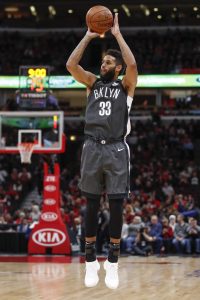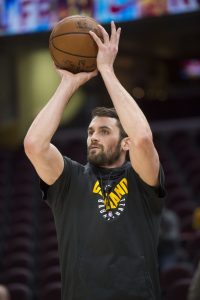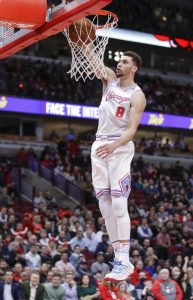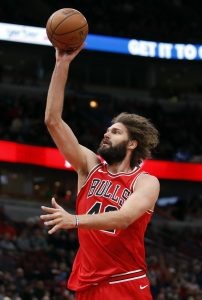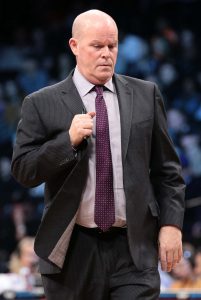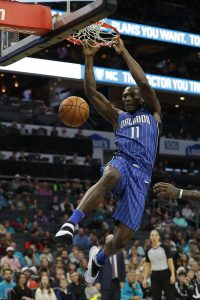The Knicks’ 29-53 record in 2017/18 was technically the team’s worst mark of the last three years, but the season as a whole didn’t feel like the worst of those three. Because the Knicks entered the ’17/18 campaign with reduced expectations, finishing 24 games below .500 wasn’t a massive disappointment — it was expected.
Of course, these wouldn’t be the modern-day Knicks if there wasn’t at least some drama and heartbreak. Joakim Noah, exiled from the team after an altercation with head coach Jeff Hornacek, was responsible for much of the drama, while Kristaps Porzingis‘ ACL tear provided the heartbreak.
Assuming Porzingis can make a full recovery from that ACL tear, the injury may actually benefit the Knicks in the long term, since Porzingis’ long recovery will force the club to exercise patience in its rebuilding process. With David Fizdale assuming the reins from Hornacek, there’s some reason for optimism in New York, but the team will have several important decisions on its plate this offseason.
Here are five key questions facing the franchise this summer:
1. What’s going on at the center position?
For much of the season, we wrote about a logjam at the center spot on the Knicks’ depth chart. After a promising rookie season, Willy Hernangomez was out of the rotation, and the same was true of the highly-paid Noah, as Enes Kanter and Kyle O’Quinn played the majority of the minutes at the five.
Now, Hernangomez is a Hornet, Noah’s future with the franchise is uncertain, and Kanter and O’Quinn both have player option decisions to make for 2018/19, raising questions about who exactly will be manning the middle for the Knicks next season.
Let’s start with the player options. O’Quinn’s decision looks simple — he’ll opt out. At that point, it will be up to the Knicks how aggressively they want to try to keep him. O’Quinn figures to get a multiyear deal, and he’ll be in line for a raise over last year’s $4MM salary.
Kanter, meanwhile, has a slightly trickier decision on his option. Exercising it seems like the right move, since he won’t match his $18.6MM option salary on the open market. However, he could exceed that figure in terms of total salary on a multiyear contract, which is why he’s been talking about opting out. If Kanter were to pick up his option, it would reduce the number of decisions for the Knicks to make, but this situation remains very much up in the air.
On the Noah front, there has been talk about waiving him after September 1, when the team could keep his $18.53MM cap hit for 2018/19 on its books, stretching his 2019/20 cap charge ($19.3MM) across three seasons. By the start of September, the Knicks’ center situation will be clearer, so perhaps it will make sense to jettison Noah if the team has a couple other solid options at the position. But with a new head coach in place and no rush to clear cap room, it might be worth keeping Noah around to see if he can bounce back at all after a lost season.
2. Is the Knicks’ long-term point guard currently on the roster?
Having previously had a glut of talent at the center position, the Knicks now find themselves with several options at point guard. However, as was the case at the five, the point guard situation could become unsettled quickly. Emmanuel Mudiay and Trey Burke will both be eligible for free agency in 2019, and the Knicks seem increasingly convinced that Frank Ntilikina might be more effective off the ball.
Ntilikina’s role will be the most pressing question for the Knicks to address, since no player on the roster is under team control for longer than the 19-year-old — no matter where he plays, he’s a future building block.
There’s no question about which position former lottery picks Mudiay or Burke should be playing, but it remains to be seen whether they can be reliable long-term contributors for the Knicks. Although Burke looked great in 36 games for New York last season, his previous 267 NBA games were much more of a mixed bag. As for Mudiay, he has also been inconsistent since entering the league in 2015, but he’s still just 22 years old, and a full training camp with the Knicks could give him a better chance to unlock his potential next season.
Read more
3. What will the Knicks do with the No. 9 pick?
While the Knicks could simply enter next season with Ntilikina, Mudiay, and Burke at the point guard spot and figure things out over the course of the year, the team’s 2018 first-rounder may provide an opportunity to land a long-term solution at the position. If Trae Young and/or Collin Sexton are on the board when New York picks at No. 9, either one might represent the best player(s) available, and a rebuilding franchise like the Knicks should be prioritizing talent over need.
Still, the Knicks will have other options. Small forwards Mikal Bridges and Miles Bridges have frequently been linked to the club, and they rank right behind Sexton at 10th and 11th on Jonathan Givony’s big board at ESPN.com, so they wouldn’t be reaches at No. 9. Villanova’s Bridges, in particular, would be a nice fit on a Knicks squad that could use a sharpshooting wing with defensive versatility.
4. Will Kristaps Porzingis be extended this offseason?
Porzingis is one of 23 players eligible for a rookie scale extension, and his case is perhaps the most interesting of the bunch. On the surface, a max extension for Porzingis as soon as possible seems like the logical move for both sides, but there are mitigating factors in play. Porzingis will still be several months away from returning to the court on July 1, when he first become extension-eligible. The Knicks might want to wait and monitor his rehab process before committing $150MM+ to a player recovering from a major knee injury.
It’s also not a certainty that Porzingis would rush into a long-term agreement with the Knicks. He has expressed some frustration with the franchise over the last couple years, and while he seems enthusiastic about the hiring of Fizdale, he may not be ready to sign away his next five seasons without having played a game for his new head coach.
Throw in the fact that waiting until 2019 on a new deal for Porzingis could give the Knicks more financial flexibility next summer, and an early extension is hardly a slam dunk. It wouldn’t surprise me if the two sides do get something done, but if they do, I think it’ll happen closer to the mid-October deadline than to July 1, when that extension window first opens.
5. Who are the trade candidates on the Knicks’ roster?
With the Knicks not looking to contend right away, the club should be willing to listen to trade offers on pieces who could help other teams immediately and may not be part of New York’s long-term plans. Courtney Lee is the most obvious candidate here — he’s coming off a very productive season (12.0 PPG, .454/.406/.919 shooting). While he’s not cheap, the remainder of Lee’s contract (two years, $25MM) isn’t bad at all compared to some of the price tags on other lesser 3-and-D players around the NBA. Lee’s name came up in trade rumors prior to the 2018 deadline, and I’d expect it to happen again this offseason.
Outside of Lee, the Knicks don’t have many clear trade candidates. Noah’s contract is virtually unmovable, Ron Baker has negative trade value, and Tim Hardaway Jr. isn’t going anywhere. The only other player who might make sense as a veteran trade chip is forward Lance Thomas. The native New Yorker isn’t really a bargain at $7.1MM, but his non-guaranteed salary for 2019/20 may appeal to teams, and he can be a useful defender and role player — even if he won’t necessarily live up to the Draymond Green comparison from his new head coach.
Here’s where things currently stand for the Knicks financially:
Guaranteed Salary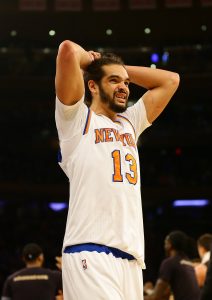
- Joakim Noah ($18,530,000)
- Tim Hardaway Jr. ($17,325,000)
- Courtney Lee ($12,253,780)
- Lance Thomas ($7,119,650)
- Kristaps Porzingis ($5,697,054)
- Ron Baker ($4,544,400): Exercised player option
- Emmanuel Mudiay ($4,294,480)
- Frank Ntilikina ($4,155,720)
- Damyean Dotson ($1,378,242)
- Total: $75,298,326
Player Options
Team Options
Non-Guaranteed Salary
Restricted Free Agents
Unrestricted Free Agents / Other Cap Holds
Projected Salary Cap: $101,000,000
Projected Cap Room: None
- There are a number of variables in play when it comes to cap space for the Knicks. Our projection assumes that Kanter will pick up his player option and that the team will retain all 10 players currently under contract – including the non-guaranteed deals – along with its first-round pick. Combining all those cap hits would take team salary to almost exactly $101MM.
Footnotes:
- Burke’s salary becomes guaranteed for $100K after July 10 and guaranteed for $400K after the first game of the 2018/19 regular season.
- Williams’ salary becomes guaranteed for $100K after August 1 and guaranteed for $200K after the first game of the 2018/19 regular season.
Note: Rookie scale cap holds are estimates based on salary cap projections and could increase or decrease depending on where the cap lands.
Salary information from Basketball Insiders was used in the creation of this post. Photos courtesy of USA Today Sports Images.




